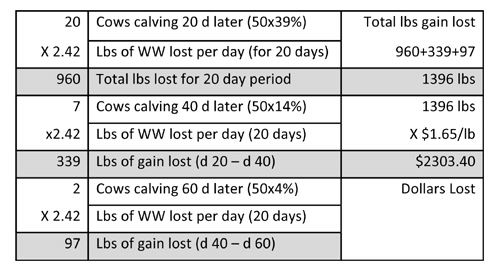Is An Extended Calving Season Costing You?
ERIN LARIMORE
JACKSON, MO.
The excitement of breeding season inspired the content for this month’s article. The quickest way to shorten a calving season is to reduce the number of days in the breeding season, but how can we determine the value of shortening the calving season? This article will shed light on the dollars you may be missing by extending the breeding/calving season.
A common misconception about having a defined breeding season is that fewer females will become pregnant and year-long breeding gets more females pregnant and, therefore, generates more revenue. However, a 12-month calving interval is targeted to maximize profitability and if a cow starts falling behind and having her calf later each year, it will have greater maintenance costs per year reducing the net income from her calf. A defined breeding season also increases the uniformity and marketability of calves increasing the likelihood of premiums.

It is estimated that for every day after the beginning of the calving season that a calf is born, 2.42 pounds of weaning weight is lost. To put this into perspective, let’s look at a 60 day breeding season with average pregnancy rates:
50 cow operation with 61 percent pregnant to AI. This means 39 percent (20 cows) will calve at least 20 days later assuming they become pregnant on their 2nd cycle. Let’s assume 14 percent will calve 40 days later if they become pregnant on 3rd cycle and 4 percent are 60 days later in pregnancy than those that conceived to AI. Please see table.
This table shows the pounds of weaning weight lost and potential dollars lost in a fairly standard breeding/calving season. Doing these calculations on your own herd may help you determine if shortening the breeding season is in your best interest. Shortening the breeding season will increase average pounds of calf weaned and selling open cows increases average net returns per calf by decreasing maintenance costs. ∆
ERIN LARIMORE: Livestock Specialist, University of Missouri